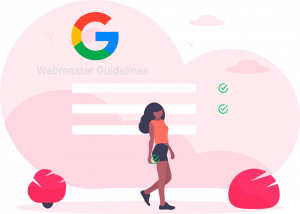(This post was originally published in 2019, however, this information is just as important today as it was then. Therefore we have republished it.)
It has long been known that anchor text is one of the key elements when it comes to building backlinks. Anchor text is the clickable text that you see in a hyperlink. It’s the words that people will click on when they go from your site to another. The right anchor text can bring a lot of value to your website, but the wrong anchor text can cause people not to click and not visit your site, which damages your site’s rankings.
However, there are many different types of anchor texts:
1) Contextual links
Contextual links are an important part of website content and can be used to link to other sites based on the subject matter. These types of links can help to increase the visibility of a website, as well as provide additional information to readers.
When creating contextual links, it is important to ensure that they are relevant to the content being discussed. For example, if you were writing an article about ‘The best restaurants in London’, you could use contextual links by linking to other websites talking about ‘The best restaurants in London’ or by using phrases like “Top 5 restaurants in London”. This will ensure that your content is better connected with other relevant websites and provides a more comprehensive experience for your readers.
Here are some examples of how contextual links can be used:
• Linking from an article about ‘The best Italian restaurants in London’ to a website listing all Italian restaurants in the city.
• Linking from an article about ‘The history of London’ to a website discussing the various landmarks around the city.
• Linking from an article about ‘Best shopping areas in London’ to a website providing detailed reviews of shops in each area.
By using contextual links, you can provide your readers with further information on the topics being discussed and help them gain a deeper understanding of the subject matter. And of course to send signals to Google that a certain page is contextually relevant to discover.
Google’s patent titled “Ranking based on reference contexts” suggests that Google may assess surrounding text when trying to understand what a linked page is about. Therefore, it is important for surrounding text to provide additional contextual clues for the content of the linked page when inserting anchor text.
In summary:
• Make sure your anchor text is contextually relevant both in terms of sentence and destination page
• Consider how surrounding text can provide additional contextual clues for the linked page
• Ensure you are directing users accurately by choosing an appropriate anchor text
2) Generic anchor text
Generic link names are highly recommended by consultants for a variety of reasons. For example, when clients include topics or themes in their website, it can be difficult to use branded or keyword-rich backlinks that are both impactful and suitable for the topic. Additionally, when dealing with multiple websites and various services, using generic anchor text can help optimize the most relevant and profitable keywords.
To illustrate this concept further, consider a landscaping company, a plumbing service, and an IT service all under the same umbrella. In order to rank well for “tree services” “plumbers” and “IT security” it would be more effective to use something like “Affordable Landscapers Services” as the hyperlink rather than “http://www.affordable-landscapers.com/” which is more generic and brand-focused.
Using generic anchor text has several advantages:
• It allows you to focus on the most relevant keywords while still including some branding elements
• It helps avoid keyword stuffing which could result in penalties from search engines
• It makes your content easier to read and understand for visitors
• It can help increase your click-through rate and page views.
More specifically, it is important to keep the following points in mind when creating anchor text:
• Keep it concise and relevant
• Use descriptive words that capture the essence of your content
• Avoid overly long phrases or sentences
• Don’t overuse keywords as this could be seen as spammy.

3) Brand name anchors
Using your website’s brand name as an anchor text can be a tricky situation. It might not be considered spammy by Google (depending on how often you use it), however, it can still have a negative impact on your rankings for that term if used too often. This is because Google considers this a form of keyword stuffing, which goes against the purpose of building backlinks with anchor texts.
It’s important to note that when using your brand name as an anchor text, you should use it sparingly and strategically. For example, if you are linking to an internal page on your website that has the same brand name in its URL, then using the brand name as an anchor text is perfectly acceptable and will not be seen as keyword stuffing by Google. The same goes if you want to link to a certain product, service, feature, or any other page that is related to your brand.
Additionally, using variations of your brand name such as acronyms or misspellings can also be helpful when trying to diversify your anchor texts. Here are some examples:
- “ABC Corp” instead of ABC Corporation
- “Corp ABC” instead of ABC Corp
- abccorp instead of ABCCorp
These small variations can help you avoid the keyword stuffing penalty from Google while still maintaining a link to your brand. And you will be surprised how many actually make spelling mistakes in their searches.
4) Links without anchors
Some websites won’t use anchors at all when linking out to another website, instead, they will just give an URL without any form of clickable text. This is also considered spammy and can negatively impact your rankings (as well as Google’s user experience).
But how do you build backlinks with anchor texts that are both relevant and search engine friendly?
There are several ways to go about this:
- Using tools like Ahrefs or Majestic you can find what keywords people are using when linking to similar sites and then use those keywords as your anchor texts. This way, the links will be relevant and search engines will understand what they’re linking to (as they usually analyze the anchor texts when deciding how valuable it is).
- You can also use a tool like Tabtimize where you’ll be able to find keywords that people are using when clicking on links on similar sites (to yours) and then use those as your anchor texts so that they relate directly with what someone would expect from clicking on that web page link (i.e for better contextually relevant backlinks). This way, both the search engines and users will be happy!
Why relevant anchor texts are important for your SEO?
Anchor text relevancy is an important factor when it comes to SEO. Search engines use anchor text relevancy to help determine the relevance of a website to a particular query. The more relevant the anchor text is to the topic of the page, the higher the link relevance score will be for that page.
When creating anchor texts, it is important to keep in mind the following:
- Links should be relevant to the topic of the page
- Links should include the target page’s important keywords or entity (can be done using natural language processing)
- Links should use an information hierarchy
- Links should have an (LRS) Link Relevance Score of at least 60.
By creating relevant anchor texts, SEO professionals, webmasters, and digital marketers can ensure that their websites are being indexed properly and appearing in the right places. This will help them stay up-to-date with the latest industry trends and maximize their SEO efforts.
Search intent and anchor text
The link & anchor text connected with the destination page must match the search intent. In other words, if the content of the anchor text is informational, then there shouldn’t be any link related to a service or product page.
For example, let’s say we have the following sentence:
“Stronger customer relationships lead to better customer loyalty.”
If we were to link this sentence to a customer relationship management (CRM) solution page, it would technically be relevant because we are discussing customer relationships. However, it doesn’t accurately reflect the intent of the anchor text which suggests that an informational article is being linked to in order to support the claim rather than a commercial page.
It’s important to remember that relevance and accuracy are key when it comes to matching link intent. Here are some tips for ensuring that your links always match their intended purpose:
• Always check that the content on your destination page matches up with what you are suggesting in your anchor text
• Be mindful of any commercial connotations associated with certain words or phrases and make sure they don’t conflict with what you are linking to
• Avoid linking out to irrelevant pages just for SEO purposes – this can be detrimental in the long run as Google will eventually catch on and penalize your website
Not only the anchored text have a saying
Using the right anchor text is an important part of SEO, but what happens when you use random anchor text? How does the search engine know what the link is about? A 2004 Google patent gives us some insight into how this works.
Google’s Patent:
According to Google’s patent, they use surrounding text to determine a link’s main topic. This means that even if the topic of the article isn’t immediately obvious, Google can still infer its purpose based on the context of the surrounding words.
Example:
To illustrate this concept, let’s look at an example from a The Telegraph article about how BBC broke impartiality rules with the Brexit report: The anchor text “broke impartiality rules ” on its own doesn’t help Google or users understand what the linked article is about. However, by looking at surrounding terms like “The BBC” and “reported on the negative impact of Brexit”, it becomes clear that this link is related to Brexit and BBC’s effects on the relationship between UK and EU officials.
In order to ensure that your links are accurately interpreted by search engines, it’s important to provide them with context and additional information that helps them understand the purpose of each link. Here are some tips for providing relevant content around your anchor text:
• Use related words or phrases that describe the topic of the linked article
• Include details about people, places, or events mentioned in the article
• Provide an overview of key ideas or themes discussed in the linked article
• Summarize any conclusions drawn in the linked article
• Bold or italicize important words and phrases for emphasis
By providing the search engine with more information about the linked article, you can help it accurately interpret your anchor text and provide users with a better experience.
Conclusion
making sure that you have contextual relevant anchors for all of your backlinks will help with both user experience (users will know exactly what they’re going to get from clicking a link on your site), as well as helping with search engine rankings (as both users and search engines will be happy with what they find on the other end of the link).
Note: An automated contextual link building tool such as the one offered by Tabtimize can help you save hours of work each month, as well as help avoid making costly mistakes along the way!



